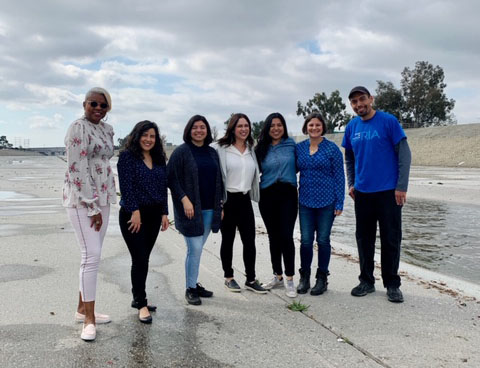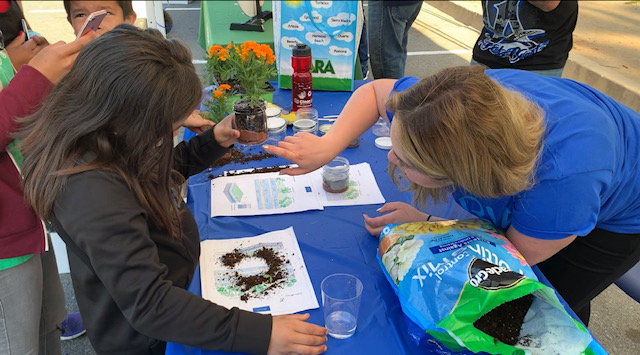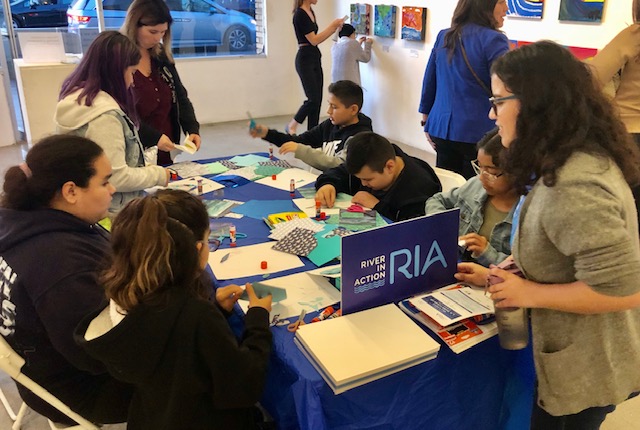Water Foundation (WF): Thanks for taking time to chat, Melissa. Let’s start with some basics. Can you introduce yourself?
Melissa Bahmanpour (MB): I’m the founder and executive director of River In Action or RIA, a nonprofit that works with communities along the Lower LA River to provide environmental education programs for Kindergarten through 5th grade (K-5) youth. We were founded in 2018 in Southeast LA and it’s where we still do most of our work.
WF: What brought you into water work in the first place? Why did you start River In Action?
MB: In addition to being the executive director of River In Action, I’m also a local elementary school teacher, and I remember one moment in 2016 that pushed me to think more critically about our relationship with the natural environment, specifically water.
The school I was working at had signs placed on all the sinks inside classrooms that stated the water was not for drinking but for hand washing only. This was a problem because we had students on campus from 7am to 6pm every day. As I asked the administration and then the school district why these signs were placed there, I became a little frustrated that no one had an answer for me. I did some more investigating, dug a little deeper, and found out that it was because of the sink fixtures and that when water sat in those fixtures lead could leach into it. I remember thinking that it shouldn’t take this much investigating to get answers about our drinking water, especially not at a school.
Not being able to get answers to simple questions about my water, both at home and at my school, was what brought me into water work. I founded River in Action because I believe in connecting children to our local natural environment and our local environmental issues. Access to clean, safe, and affordable drinking water is one of those issues. I’m also very lucky I’m able to do this work alongside a team of educators, students, and families who both made the founding of River in Action possible and continue to help it grow.
At River In Action, we hold workshops for students on local groundwater and watershed issues, including drinking water. During the pandemic we want to find ways to support our children and our local schools even though we can’t meet in person right now. We recently distributed environmental craft kits to 100 families and we’re holding a virtual environmental science camp this November.

River In Action board members, Gabriel Enamorado.
WF: How have community members, parents, and students been responding to these different environmental science programs?
MB: Before we became an official 501(c)3 organization, we were a group of educators and community members in Southeast Los Angeles who hosted river clean-ups and small workshops. As we saw our communities express interest in the work we were doing we knew we needed to build capacity to offer more. That’s the reason we decided to become a formal 501(c)3.
In addition to the environmental side of RIA’s work, there is also a strong science focus. As a K-5 classroom teacher I see firsthand how science is not a priority subject in elementary schools, even though parents express high interest in it, and I think we see the effects of that in middle school, high school, and beyond.
Environmental science is critical because it helps children understand the natural world around them and prepare for a changing climate.
The reason we make sure our programs are free is because we strongly believe that a family’s socioeconomic resources should not impact their children’s access to science education.
We believe that engaging young children in environmental education will help them become more powerful social change agents as they grow up, something that is extremely important in communities that continue to face environmental and health injustices.

Students at a local environmental science workshop, River In Action.
WF: That’s a good segue to your role on the Lower LA River Watershed Area Steering Committee or WASC. LA’s new Safe Clean Water Program relies on nine of these committees to help recommend and oversee new projects and funding decisions. What is your role on the committee for the Lower LA River watershed?
MB: I am an appointed member of the Lower LA River watershed area steering committee and in that role I advocate to ensure projects receiving funding from the Safe Clean Water Program in our watershed are multiple benefit projects and in communities where they are most needed.
I hope to encourage future project applicants to connect with local schools and school districts in an effort to connect K-12 learning to stormwater capture and green infrastructure projects.
There’s a great opportunity to fund projects that both better our water and serve as powerful teaching tools.
I believe the Safe Clean Water Program is going to have a K-12 outreach program and I’m really looking forward to that. It’s a great opportunity to engage communities in water sustainability work.
WF: The focus on students and young people is important. Decisions today need to be thinking about future needs and about the environment in which these students are going to grow up and be adults.
MB: Exactly, they are the ones who are going to be the recipients of the benefits of these projects. They are also the ones who are going to have to handle issues presented by a changing climate and continued environmental injustices many communities already face.
WF: You’re also a part of the Water Leaders Working Group, which is convened by the OurWaterLA to support community representatives serving on the Safe Clean Water Program committees. How has that gone?
MB: The working group has been a great support system as I go through the WASC process. I come from the nonprofit and education worlds and don’t have the science background that some of the other WASC members have. The working group meetings have helped me get closer to the same footing as other WASC members in terms of understanding the technical aspects of green infrastructure and stormwater capture.
It also lets me connect with other WASC members who are in the same boat as me. They are also community representatives or NGO representatives and may not have the science background. It’s nice to support each other as we move through this process. I believe it has made me a more useful and powerful member of my WASC.
WF: The Safe Clean Water Program is supposed to fund multi-benefit projects and equitable investments in communities of color and low-income neighborhoods. 2020 is the program’s first year. How do you think it’s going towards achieving these goals?
MB: This past year has been a learning experience for everyone. As WASC members, I think we’re understanding our roles better and what comes with that role. I think moving forward the WASCs will be even more efficient and effective. I believe that as word about the Safe, Clean Water Program continues to spread we’ll see more project proposals and even stronger project proposals. I’m excited to see what happens in the next round [in 2021].
WF: Okay, final question. You’ve shared how learning environmental science can help empower people, whether as they grow up in a community or in public service roles like yours as a WASC member. What should policymakers and philanthropy be doing to support this?
MB: In terms of philanthropy, support local on-the-ground nonprofits. In terms of policy, I would like to see an increased focus on funding mechanisms in order to truly implement some of the legislation that’s already been passed around drinking water. I’ve seen it through my role at River In Action and as an educator- legislation is passed with the best of intentions, but when there is a lack of funding it falls by the wayside. I believe funding is critical in ensuring every Californian’s human right to clean and safe water. I also believe our state is up to the challenge.
